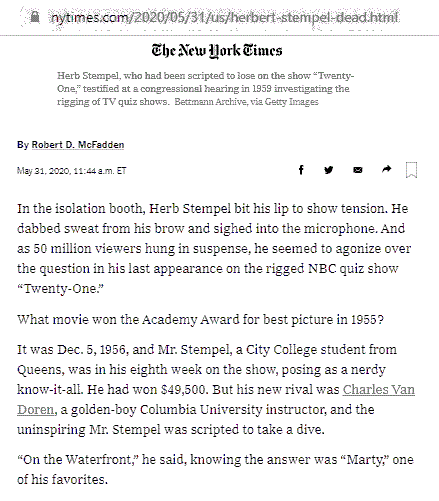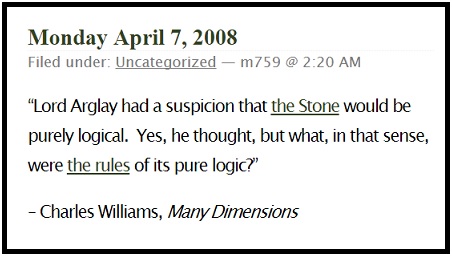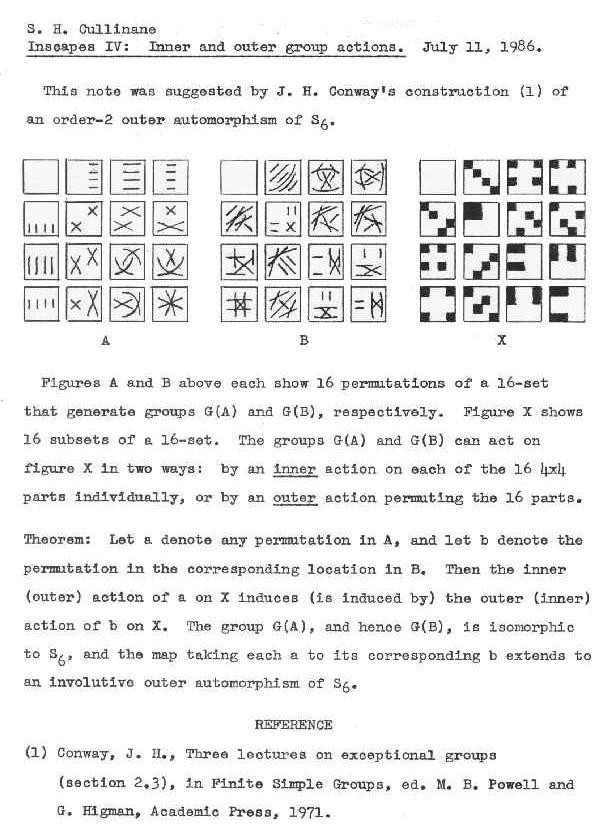x
Tuesday, April 7, 2009
Tuesday April 7, 2009
|
Bright Star and Dark Lady “Mexico is a solar country — but it is also a black country, a dark country. This duality of Mexico has preoccupied me since I was a child.” — Octavio Paz, |
||
|
Bright Star
|
Amen.
|
Dark Lady
|
The same story on
May 11, 2005
with a different
dark lady:

Monday, April 7, 2008
Monday April 7, 2008
who invented kindergarten:

For further details, see
Gift of the Third Kind
and
Kindergarten Relativity.
Related material:
Monday April 7, 2008
The Class,
Without the Classes”
— The New York Times
on the date of
Charlton Heston’s death
“Leave a space.”
— Tom Stoppard
in “Jumpers”

“Heaven is a state, a sort of
metaphysical state.”
— John O’Hara,
Hope of Heaven
Monday April 7, 2008
“Lord Arglay had a suspicion that
— Charles Williams, Many Dimensions
Saturday, April 7, 2007
Saturday April 7, 2007
Francis Ford Coppola
and Russell Crowe
Gift of the Third Kind
Background:
Art Wars and
Russell Crowe as
Santa's Helper.
who invented kindergarten:
From Christmas 2005:
Related material from
Pittsburgh:
… and from Grand Rapids:
Related material
for Holy Saturday:
Friday, April 7, 2006
Friday April 7, 2006
in Poetry Month

Tomorrow is the final day
for the Liza Lou exhibit at
London’s White Cube gallery.
For related material, see
Log24, March 24-26, and
the entries culminating
on Pi Day.
Thursday, April 7, 2005
Thursday April 7, 2005
In the Details
Wallace Stevens,
An Ordinary Evening in New Haven:
XXII
Professor Eucalyptus said, "The search
For reality is as momentous as
The search for God." It is the philosopher's search
For an interior made exterior
And the poet's search for the same exterior made
Interior….
… Likewise to say of the evening star,
The most ancient light in the most ancient sky,
That it is wholly an inner light, that it shines
From the sleepy bosom of the real, re-creates,
Searches a possible for its possibleness.
Julie Taymor, "Skewed Mirrors" interview:
"… they were performing for God. Now God can mean whatever you want it to mean. But for me, I understood it so totally. The detail….
They did it from the inside to the outside. And from the outside to the in. And that profoundly moved me then. It was…it was the most important thing that I ever experienced."
The above may be of interest to students
of iconology — what Dan Brown in
The Da Vinci Code calls "symbology" —
and of redheads.
The artist of Details,
"Brenda Starr" creator
Dale Messick, died on Tuesday,
April 5, 2005, at 98.
For further details on
April 5, see
Art History:
The Pope of Hope

Thursday April 7, 2005
“Heaven is a state,
a sort of metaphysical state.”
— John O’Hara, Hope of Heaven, 1938

“Mathematical realism holds that mathematical entities exist independently of the human mind. Thus humans do not invent mathematics, but rather discover it, and any other intelligent beings in the universe would presumably do the same. The term Platonism is used because such a view is seen to parallel Plato’s belief in a “heaven of ideas”, an unchanging ultimate reality that the everyday world can only imperfectly approximate. Plato’s view probably derives from Pythagoras, and his followers the Pythagoreans, who believed that the world was, quite literally, built up by the numbers. This idea may have even older origins that are unknown to us.” — Wikipedia
Related material:
In memory of Jesus of Nazareth,
the “true vine,”
who, some historians believe,
died on this date:
The Crucifixion of John O’Hara.
In memory of the Anti-Vine:

See Dogma and
Heaven, Hell,
and Hollywood.
Related material:
and
Thursday, December 26, 2002:
Holly for Miss Quinn
Tonight’s site music is for Stephen Dedalus
and Miss Quinn, courtesy of Eithne Ní Bhraonáin.
|
Miss Quinn |
Holly |
Eithne |
Thursday April 7, 2005
From Maureen Dowd’s New York Times column of June 9, 2002:
“The shape of the government is not as important as the policy of the government. If he makes the policy aggressive and pre-emptive, the president can conduct the war on terror from the National Gallery of Art.”
|
Today’s birthdays: Francis Ford Coppola and From MindfulGroup.com:
|

To order, see the
Amazing Music Box & Gifts Company.
Wednesday, April 7, 2004
Wednesday April 7, 2004
Today’s birthdays:
Francis Ford Coppola and
Russell Crowe.
From MindfulGroup.com:
|
Welcome to our imaginative and inspiring toy catalog! Today is Wednesday 7-April 2004. On this day in 30 Jesus crucified by Roman troops in Jerusalem (scholars’ estimate) What you will discover in this site is what we have been able to find in our everlasting search for the most original, innovative, amusing and mind bending toys from around the world. Have Fun. Coliseum Tell me more |
Wednesday April 7, 2004
ART WARS:
Mother of Beauty
In memory of architect Pierre Koenig…
Mother of Beauty: A Note on Modernism.
“… Case Study House #22 … was high drama — one in which the entire city becomes part of the architect’s composition. Approached along a winding street set high in the Hollywood Hills, the house first appears as a blank concrete screen. From here, the visitor steps out onto a concrete deck that overlooks a swimming pool. Just beyond it, the house’s living room — enclosed in a glass-and steel-frame — cantilevers out from the edge of the hill toward the horizon.
The house was immortalized in a now famous image taken by the architectural photographer Julius Shulman. In it, two women, clad in immaculate white cocktail dresses, are perched on the edge of their seats in the glass-enclosed living room, their pose suggesting a kind of sanitized suburban bliss. A night view of the city spreads out beneath them, an endless grid of twinkling lights that perfectly captures the infinite hopes of the postwar American dream….
“My blue dream…”
— F. Scott Fitzgerald
Perhaps no house, in fact, better sums up the mix of outward confidence and psychic unease that defined Cold War America….”
Monday, April 7, 2003
Monday April 7, 2003
Math Awareness Month
April is Math Awareness Month.
This year's theme is "mathematics and art."

Monday April 7, 2003
An Offer He Couldn't Refuse
Today's birthday: Francis Ford Coppola is 64.
"There is a pleasantly discursive treatment
of Pontius Pilate's unanswered question
'What is truth?'."
— H. S. M. Coxeter, 1987, introduction to Richard J. Trudeau's remarks on the "Story Theory" of truth as opposed to the "Diamond Theory" of truth in The Non-Euclidean Revolution
"Then came From Here to Eternity. Sinatra lobbied hard for the role, practically getting on his knees to secure the role of the street smart punk G.I. Maggio. He sensed this was a role that could revive his career, and his instincts were right. There are lots of stories about how Columbia Studio head Harry Cohn was convinced to give the role to Sinatra, the most famous of which is expanded upon in the horse's head sequence in The Godfather. Maybe no one will know the truth about that. The one truth we do know is that the feisty New Jersey actor won the Academy Award as Best Supporting Actor for his work in From Here to Eternity. It was no looking back from then on."
From a note on geometry of April 28, 1985:
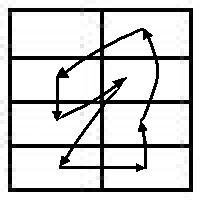
Friday, April 14, 2023
“Apart from that, Mrs. Koren . . .”
The New York Times reports an April 14 death.
See as well Vermont as A Metaphysical State .
UPDATE:

THE SOURCE:
https://www.newyorker.com/gallery/
cartoons-from-the-april-17-2023-issue.
The date at the bottom, April 7, was Good Friday.
Thursday, April 6, 2023
A Literary Supplement
Religious remarks in the Times Literary Supplement
issue dated April 7, 2023 (Good Friday) suggest a
review of other remarks — from July 1, 2019 —now
tagged The Exploded Cube. Some will prefer more useful
types of explosions.
Monday, April 3, 2023
The Good Friday Film Festival continues.
Friday, May 6, 2022
Interality and the Bead Game
WIkipedia on the URL suffix ".io" —
"In computer science, "IO" or "I/O" is commonly used
as an abbreviation for input/output, which makes the
.io domain desirable for services that want to be
associated with technology. .io domains are often used
for open source projects, application programming
interfaces ("APIs"), startup companies, browser games,
and other online services."
An association with the Bead Game from a post of April 7, 2018 —
|
Glasperlenspiel passage quoted here in Summa Mythologica —
“"I suddenly realized that in the language, or at any rate A less poetic meditation on the above 4x4x4 design cube —
"I saw that in the alternation between front and back, See also a related remark by Lévi-Strauss in 1955:
"…three different readings become possible: |
The recent use by a startup company of the URL "interality.io" suggests
a fourth reading for the 1955 list of Lévi-Strauss — in and out —
i.e., inner and outer group automorphisms — from a 2011 post
on the birthday of T. S. Eliot :
A transformation:
Click on the picture for details.
Wednesday, April 13, 2022
Dealing with Cubism continues . . .
Friday, April 8, 2022
The Ugly Lesson: Time Is Money
The above out-of-context quotation illustrates the following lesson,
from the Amazon.com page quoted in this moning's Souls at Stanford —
See as well 1949 in the April 7 post
The Usual Suspects.
Thursday, April 7, 2022
The Usual Suspects
In memory of a musical that opened on this date —
April 7 — in 1949 . . .
See the same date in The Source , by James Michener (1965):

Saturday, June 5, 2021
Times Square Logic
Dialogue from Season 1, Episode 8 of "His Dark Materials" —
|
Asriel: And the serpent said, "You shall not surely die, for the Authority doth know that on that day that ye eat thereof, your eyes shall be opened, your daemons shall assume their true form and ye shall be as…" Both: "… gods, knowing good and…" Lyra: "… evil." Asriel: "… Dust ." You see? They have been trying to convince us for centuries that we are born guilty. And that we have to spend a lifetime atoning for the crime of eating an apple. Is there any proof for this heinous stain, this shame, this guilt? No, not at all. We are to take it on faith, and on the word of the Authority. But Dust… Dust is an elementary particle that we can record, measure, study.
Read more at: |
Related material: Times Square Logic. Log24 posts now tagged
"Times Square Logic" include two from April 7, 2015, the date of
Geoffrey Lewis's death.
Lewis played, notably, "Hard Case Williams" in Lust in the Dust (1984).
Sunday, May 31, 2020
Friday, November 1, 2019
7 8 9 … Heaven Gate Vine
For the title, see Mnemonic and April 7, 2005.
Wednesday, August 1, 2018
Abschattungen*
“… I realized that to me, Gödel and Escher and Bach
were only shadows cast in different directions
by some central solid essence.
I tried to reconstruct the central object . . . ."
— Douglas Hofstadter (1979)
See also posts of July 23, 2007, and April 7, 2018.
* Term from a visual-culture lexicon —

Wednesday, May 3, 2017
Bosch House
Continued from Music Box – The Theory (April 21)
in memory of jazz enthusiast Ann Sneed,
who reportedly died in Las Vegas at 87 on that date.

Hollywood homicide detective Harry Bosch at home.
See also Mother of Beauty (April 7, 2004).
Sunday, April 16, 2017
Risen?
In memory of a mathematician who
reportedly died at 64 on April 4
Part I: A review by that mathematician —
Part II: The mathematician's funeral —
"Funeral service will be held at 1:30 p.m. on Friday, April 7, 2017 . . . ."
— See more at: http://www.legacy.com/obituaries/dispatch/
obituary.aspx?n=David-Mark-Goss&pid=184946410
This journal at 1:37 p.m. ET on Friday, April 7, 2017 —

Related material:
The previous post and posts tagged The Gray Legacy.
Saturday, April 8, 2017
Eye
"I guess I found my future through Billy Name’s eye.
I saw his pictures of the Warhol Factory when I was
in college and thought, 'Oh that’s the place to get to.
Everyone is so beautiful and it looks brilliant and
complicated – art, music, film, but most of all a kind
of wild life.' It looked like the future as I imagined it."
— The late Glenn O'Brien in The Guardian
on November 8, 2014. O'Brien reportedly
died at 70 yesterday, Friday (April 7) morning,
in Manhattan.
"… through Billy Name's eye …."
Then there is Kurt Seligmann's eye …
The above-mentioned Billy Name appeared in this journal
in July 2016 in the post "Coterie (for Philip Rieff)." Also
featured in that post was artist Kurt Seligmann.
A Google Search sidebar on Seligmann today:

Synchronology check of this journal on the above Guardian date:
|
Saturday, November 8, 2014
At 11:59*
|
See also an 11:59 PM ET post on Thursday, April 6, titled
"Where Entertainment Is God (continues)."
Some related entertainment:


I do not recommend any of the above entertainments,
but they do supply some background for the article
"Fantasy and the Buffered Self" (which is recommended.)
Saturday, February 11, 2017
Ultima Thule
"Skip the preface, and it's in the bag!"
— Character in a short story by Nabokov,
"Ultima Thule," in The New Yorker of April 7, 1973
Wednesday, August 10, 2016
Narratives
The novel Blood on Snow , set in Oslo, was published
by Knopf on April 7, 2015. This journal on that date —
|
Log24 on Tuesday, April 7, 2015 Filed under: Uncategorized — m759 @ 7:00 PM Seven years ago in this journal — |
A related image —

Thursday, April 7, 2016
Plan 9 Continues (Very Slowly)
From the American Mathematical Society today —
|
Verena Huber-Dyson (1923-2016) Huber-Dyson, who worked in group theory and logic, died March 12 at the age of 92. She was born to Swiss parents in Naples and grew up in Athens but moved with her family to Switzerland in 1940 because of the war. Huber-Dyson received her PhD from the University of Zurich in 1947 and moved to the U.S. in 1948 for a post-doctoral fellowship at the Institute for Advanced Study. She held positions at many universities around the world and taught courses on the foundation of mathematics as a philosophy professor at the University of Calgary from 1973 to 1988. Her son, George Dyson, said that her last words were, "This will all go smoothly. Let's get going." She was an AMS member since 1949. Read more about her life. |
See also Huber-Dyson in this journal.
Thursday, January 7, 2016
Point Omega…
… Continues. See previous episodes.
See as well …
-
Types of Ambiguity : Galois Meets Doctor Faustus,
from December 14, 2010.
-
From Jan. 5, the date of Pierre Boulez's death,
a post on Galois geometry.
- 2016 Joint Mathematics Meetings

The above image is from April 7, 2003.
Monday, April 27, 2015
Hell’s Kitchen
A heavenly image from yesterday's
Sunday Dinner link "milestone award"—

An Oprah-related quote from the Tuesday, April 7,
ceremonial dedication of the Maya Angelou stamp—
“They say Easter was Sunday, but we are still
having church,” promised MSNBC talk show
host Melissa Harris-Perry, the ceremony’s emcee…."
In that spirit … a different sort of kitchen —
Monday, April 20, 2015
Immaculate Inception
Continued from a post of April 10, 2015 —

Maya Angelou stamp with
misattributed quote and
Oprah on April 7, 2015
Trailer for "Welcome to Me" published on Feb. 23, 2015 —
Related material: Manifest O (April 1, 2015).
Saturday, April 18, 2015
The Acme Corporation Presents…

Kyle Smith on April 15 in the New York Post —
"The ludicrous action thriller 'Beyond the Reach'
fails to achieve the Southwestern noir potency
of 'No Country for Old Men,' but there’s no denying
it brings to mind another Southwestern classic
about malicious pursuit: the Road Runner cartoons."
Related material:
-
Legespiel Meets Würfelspiel in…
Gift of the Third Kind
(April 7, 2007), featuring Ellen Yi-Luen Do — -
the current home page of Ellen Yi-Luen Do,
now at Georgia Tech, and… - a page about her ACME Lab —
|
Welcome to ACME lab!
Yes, the name is both confusing and has
We call it ACME Creativity Machine Environment – We like recursive ideas. |
Thursday, April 9, 2015
Translation
From an informative April 7 essay in The Nation —
|
In his marvelous book Is That a Fish in Your Ear?: Translation and the Meaning of Everything , David Bellos demonstrates many of the ways that translation is not only possible but ubiquitous, so thoroughly woven into the fabric of our daily lives—from classrooms to international financial markets, from instruction manuals to poems—that if translation were somehow to become impossible, the world would descend into the zombie apocalypse faster than you can say “je ne sais quoi ." — "Forensic Translation," by Benjamin Paloff |
See also searches in this journal for Core and for Kernel.
See as well Fabric Design and Symplectic.
Thursday, February 7, 2013
Mathematics and Narrative, continued…
Primes Are Forever
"If diamonds are a girl's best friend,
prime numbers are a mathematician's….
A Mersenne prime is of the form 2P-1,
where the variable P is itself a prime—
making the Mersenne an elite sort of prime,
a James Bond among spies."
— Anonymous author at
Fox News, Feb. 5, 2013
The author notes that the smaller
Mersenne primes include 7.
Related Material
April is Math Awareness Month.
This year's theme is "mathematics and art."

Update of 2:56 PM Feb. 7:
See also Paul Bateman and, in this journal, the date of Bateman's death.
For mathematics rather than narrative, see (for instance)…
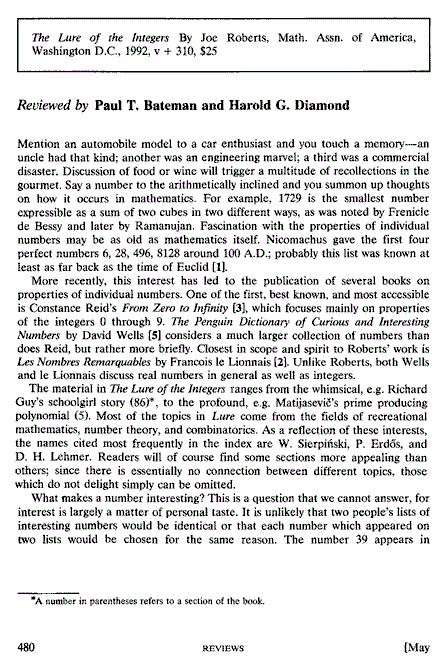 .
.
Thursday, August 30, 2012
The Cruelest Month
Last night's 10 PM post linked to an April 7, 2012,
post that through a series of further links leads
to Columbia Film Theory .
For other film-related remarks, by a
Columbia alumnus,* see last night's post.
See also the 1.3 MB image from Aug. 16, the night
of Elvis's Wrap Party. An excerpt from that image
stars Amy Adams—

For Amy, from the current New Yorker—
The Master—

* N.O.C.D.
Wednesday, August 29, 2012
It’s 10 PM…
Do you know where your children are?
Continued from Plan 9 , a Log24 post of 9 PM Monday—
See another weblog's April 7, 2012, post on
God and Horror Movies.
See also this weblog's post on that date.
Friday, April 13, 2012
The Primate and the Bee
"Man is, in Lévi-Strauss's view, a mythopoetic primate
(it's a difficult phrase but we don't have a better one)…."
Pope Benedict XVI at the 2012 Easter Vigil on April 7 —
"The great hymn of the Exsultet, which the deacon sings at the beginning of the Easter liturgy, points us quite gently towards a further aspect. It reminds us that this object, the candle, has its origin in the work of bees. So the whole of creation plays its part. In the candle, creation becomes a bearer of light.
But in the mind of the Fathers, the candle also in some sense contains a silent reference to the Church. The cooperation of the living community of believers in the Church in some way resembles the activity of bees. It builds up the community of light."

Thursday, May 26, 2011
Life’s Persistent Questions
This afternoon's online New York Times reviews "The Tree of Life," a film that opens tomorrow.
With disarming sincerity and daunting formal sophistication “The Tree of Life” ponders some of the hardest and most persistent questions, the kind that leave adults speechless when children ask them. In this case a boy, in whispered voice-over, speaks directly to God, whose responses are characteristically oblique, conveyed by the rustling of wind in trees or the play of shadows on a bedroom wall. Where are you? the boy wants to know, and lurking within this question is another: What am I doing here?
Persistent answers… Perhaps conveyed by wind, perhaps by shadows, perhaps by the New York Lottery.
For the nihilist alternative— the universe arose by chance out of nothing and all is meaningless— see Stephen Hawking and Jennifer Ouellette.
Update of 10:30 PM EDT May 26—
Today's NY Lottery results: Midday 407, Evening 756. The first is perhaps about the date April 7, the second about the phrase "three bricks shy"— in the context of the number 759 and the Miracle Octad Generator. (See also Robert Langdon and The Poetics of Space.)
Tuesday, May 3, 2011
24-Part Invention
“Next to the bookcase stands a wooden cabinet with 24 drawers that looks like something you might have seen in a library decades ago, or perhaps in an old apothecary. The drawers are marked with the names of her novels or characters in the novels and crammed with indexed notes.
She pulls open a drawer marked ‘Lozen,’ the name of a main female character in another historical western novel, ‘The Ghost Warrior,’ and reads a few of the index tabs: ‘social relationships, puberty, death, quotes….'”
— From an article on Lucia St. Clair Robson in The Baltimore Sun by Arthur Hirsch, dated 1:31 p.m. EDT April 30, 2011*
From this journal later that same day —
 |
Robson’s most recent novel is Last Train from Cuernavaca .
“A corpse will be transported by express!”
— Malcolm Lowry, Under the Volcano
* Update of 5:48 AM EDT May 3—
The same article was also published with a different dateline— April 28.
Enthusiasts of synchronicity may lament the confusion, or they may
turn to April 28 in this journal for a different 24-part invention.
See also Art Wars, April 7, 2003 and White Horse .
Monday, May 2, 2011
The Vine*
See "Nine is a Vine" and "Hereafter" in this journal.
As quoted here last October 23—
Margaret Atwood on Lewis Hyde's Trickster Makes This World: Mischief, Myth, and Art—
"Trickster is among other things the gatekeeper who opens the door into the next world; those who mistake him for a psychopath never even know such a door exists." (159)
What is "the next world"? It might be the Underworld….
The pleasures of fabulation, the charming and playful lie– this line of thought leads Hyde to the last link in his subtitle, the connection of the trickster to art. Hyde reminds us that the wall between the artist and that American favourite son, the con-artist, can be a thin one indeed; that craft and crafty rub shoulders; and that the words artifice, artifact, articulation and art all come from the same ancient root, a word meaning "to join," "to fit," and "to make." (254) If it’s a seamless whole you want, pray to Apollo, who sets the limits within which such a work can exist. Tricksters, however, stand where the door swings open on its hinges and the horizon expands: they operate where things are joined together, and thus can also come apart.
Friday, April 15, 2011
The Enchanted Sequel
Today's mid-day NY lottery number was 407. See April 7 in this journal.
The sequel—Today's evening NY lottery number was 930. See Castle Rock.
Thursday, April 7, 2011
Awake in Seattle
From University Book Store, Seattle, Washington—

Related material—
|
The Use and Abuse |
From a page on Reality Hunger: A Manifesto at DavidShields.com—
"The book's epigraph is a statement from Picasso: 'All art is theft.'"
Update of 3 PM EDT April 7—
"… we get inspiration from everywhere, and there's a bright line between inspiration and slavish imitation. (I was going to throw in the Picasso quote 'All art is theft' here, but I've looked that up in both the Oxford Dictionary of Quotations (and the Oxford Dictionary of Modern Quotations
, just in case) and in the new Yale Book of Quotations
, and can't find it. So I'll just have to steal without the glamour of Picasso having said it was okay.)"
— Weblog post by Erin McKean
Tuesday, August 10, 2010
Architecture Continued
Yesterday's architectural entertainment coincided, more or less, with the New York Times article "The Hand of a Master Architect" (Online Sunday, Aug. 8, and in the print edition Monday, Aug. 9).
A search for some background on that architect (Philip Johnson, not Howard Roark) showed that the Art Libraries Society of North America published a notable graphic logo in 2005—

See this journal on April 7, 2005, for a related graphic design.
The ARLIS/NA 2005 page cited above says about Houston, Texas, that
"Just beyond the museum district lies Rice University, the city's most prestigious and oldest college….
Other campuses that contain significant architecture include St. Thomas University where Philip Johnson has made his mark for a period that extends more than forty years."

University of St. Thomas, Chapel of St. Basil
Applying Jungian synchronicity, we note that Johnson designed the Chapel of St. Basil at the University of St. Thomas, that the traditional date of the Feast of St. Basil is June 14, and that this journal on that date contained the following, from the aforementioned Rice University—
… a properly formulated Principle of Sufficient Reason plays
a fundamental role in scientific thought and, furthermore, is
to be regarded as of the greatest suggestiveness from the
philosophic point of view.2
… metaphysical reasoning always relies on the Principle of
Sufficient Reason, and… the true meaning of this Principle
is to be found in the “Theory of Ambiguity” and in the associated
mathematical “Theory of Groups.”
If I were a Leibnizian mystic, believing in his “preestablished
harmony,” and the “best possible world” so satirized by Voltaire
in “Candide,” I would say that the metaphysical importance of
the Principle of Sufficient Reason and the cognate Theory of Groups
arises from the fact that God thinks multi-dimensionally3
whereas men can only think in linear syllogistic series, and the
Theory of Groups is the appropriate instrument of thought to
remedy our deficiency in this respect.
The founder of the Theory of Groups was the mathematician
Evariste Galois….
2 As far as I am aware, only Scholastic Philosophy has fully recognized
and exploited this principle as one of basic importance for philosophic thought.
3 That is, uses multi-dimensional symbols beyond our grasp.
For more about Scholastic Philosophy, see the Center for Thomistic Studies at the University of St. Thomas.
For more about the graphic symbol shown (as above) by ARLIS and by Log24 in April 2005, see in this journal "rature sous rature ."
Wednesday, April 7, 2010
Veritas
Some historians consider today's date, April 7, to be the date of the Crucifixion in the Roman calendar (a solar calendar, as opposed to the Jewish lunar scheme).
Since the ninefold square has been called both a symbol of Apollo and the matrix of a cross, it will serve as an icon for today–

Adapted from
Ad Reinhardt
Friday, September 4, 2009
Friday September 4, 2009
Continued from Monday
“This is a chapel
of mischance;
ill luck betide it, ’tis
the cursedest kirk
that ever I came in!”
Philip Kennicott on
Kirk Varnedoe in
The Washington Post:
“Varnedoe’s lectures were
ultimately about faith,
about his faith in
the power of abstraction,
and abstraction as a kind of
anti-religious faith in itself….”
Kennicott’s remarks were
on Sunday, May 18, 2003.
They were subtitled
“Closing the Circle
on Abstract Art.”
Also on Sunday, May 18, 2003:
“Will the circle be unbroken?
As if some southern congregation
is praying we will come to understand.”
Princeton University Press:
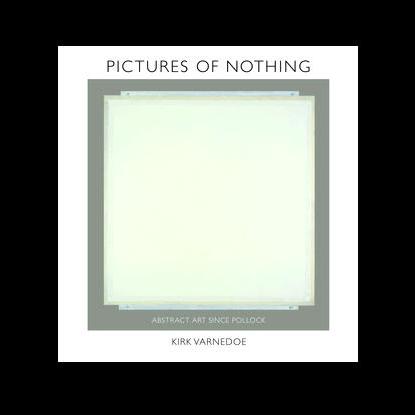
See also
Parmiggiani’s
Giordano Bruno —

Dürer’s Melencolia I —

and Log24 entries
of May 19-22, 2009,
ending with
“Steiner System” —

George Steiner on chess
(see yesterday morning):
“Allegoric associations of death with chess are perennial….”
Yes, they are.
April is Math Awareness Month.
This year’s theme is “mathematics and art.”

Cf. both of yesterday’s entries.
Thursday, July 16, 2009
Thursday July 16, 2009
continued from
April 7, 2004In memory of Julius Shulman,
architectural photographer,
who died last night:
“And the lotos rose, quietly, quietly,
The surface glittered out of heart of light…”
— Four Quartets, quoted here
November 22, 2004
Sunday, April 12, 2009
Sunday April 12, 2009
Is God, continued
Dialogue from the classic film Forbidden Planet—
"… Which makes it a gilt-edged priority that one of us gets into that Krell lab and takes that brain boost."
— Taken from a video (5:18-5:24 of 6:09) at David Lavery's weblog in the entry of Tuesday, April 7.
(Cf. this journal on that date.)
Thanks to Professor Lavery for his detailed notes on his viewing experiences.
My own viewing recently included, on the night of Good Friday, April 10, the spiritually significant film Indiana Jones and the Kingdom of the Crystal Skull.
The mystic circle of 13 aliens at the end of that film, together with Leslie Nielsen's Forbidden Planet remark quoted above, suggests the following:
|
"The aim of Conway’s game M13 is to get the hole at the top point and all counters in order 1,2,…,12 when moving clockwise along the circle." —Lieven Le Bruyn
The illustration is from the weblog entry by Lieven Le Bruyn quoted below. The colored circles represent 12 of the 13 projective points described below, the 13 radial strokes represent the 13 projective lines, and the straight lines in the picture, including those that form the circle, describe which projective points are incident with which projective lines. The dot at top represents the "hole."
From "The Mathieu Group M12 and Conway’s M13-Game" (pdf), senior honors thesis in mathematics by Jeremy L. Martin under the supervision of Professor Noam D. Elkies, Harvard University, April 1, 1996–
"Let P3 denote the projective plane of order 3. The standard construction of P3 is to remove the zero point from a three-dimensional vector space over the field F3 and then identify each point x with -x, obtaining a space with
Conway [3] proposed the following game…. Place twelve numbered counters on the points… of P3 and leave the thirteenth point… blank. (The empty point will be referred to throughout as the "hole.") Let the location of the hole be p; then a primitive move of the game consists of selecting one of the lines containing the hole, say There is an obvious characterization of a move as a permutation in S13, operating on the points of P3. By limiting our consideration to only those moves which return the hole to its starting point…. we obtain the Conway game group. This group, which we shall denote by GC, is a subgroup of the symmetric group S12 of permutations of the twelve points…, and the group operation of GC is concatenation of paths. Conway [3] stated, but did not prove explicitly, that GC is isomorphic to the Mathieu group M12. We shall subsequently verify this isomorphism. The set of all moves (including those not fixing the hole) is given the name M13 by Conway. It is important that M13 is not a group…." [3] John H. Conway, "Graphs and Groups and M13," Notes from New York Graph Theory Day XIV (1987), pp. 18–29. Another exposition (adapted to Martin's notation) by Lieven le Bruyn (see illustration above):
"Conway’s puzzle M13 involves the 13 points and 13 lines of P3. On all but one point numbered counters are placed holding the numbers 1,…,12 and a move involves interchanging one counter and the 'hole' (the unique point having no counter) and interchanging the counters on the two other points of the line determined by the first two points. In the picture [above] the lines are represented by dashes around the circle in between two counters and the points lying on this line are those that connect to the dash either via a direct line or directly via the circle. In the first part we saw that the group of all reachable positions in Conway's M13 puzzle having the hole at the top position contains the sporadic simple Mathieu group M12 as a subgroup." |
For the religious significance of the circle of 13 (and the "hole"), consider Arthur and the 12 knights of the round table, et cetera.

Thursday, April 9, 2009
Thursday April 9, 2009
continued from
March 28, 2003

Related material:
One Ring to
Rule Them All
(Sept. 2, 2003)
and
Indiana Jones and the
Diadem of Death
(May 29, 2008)
Tuesday, March 10, 2009
Tuesday March 10, 2009
“Music, mathematics, and chess are in vital respects dynamic acts of location. Symbolic counters are arranged in significant rows. Solutions, be they of a discord, of an algebraic equation, or of a positional impasse, are achieved by a regrouping, by a sequential reordering of individual units and unit-clusters (notes, integers, rooks or pawns). The child-master, like his adult counterpart, is able to visualize in an instantaneous yet preternaturally confident way how the thing should look several moves hence. He sees the logical, the necessary harmonic and melodic argument as it arises out of an initial key relation or the preliminary fragments of a theme. He knows the order, the appropriate dimension, of the sum or geometric figure before he has performed the intervening steps. He announces mate in six because the victorious end position, the maximally efficient configuration of his pieces on the board, lies somehow ‘out there’ in graphic, inexplicably clear sight of his mind….”
“… in some autistic enchantment, pure as one of Bach’s inverted canons or Euler’s formula for polyhedra.”
— George Steiner, “A Death of Kings,” in The New Yorker, issue dated Sept. 7, 1968
“Classrooms are filled with discussions not of the Bible and Jesus but of 10 ‘core values’– perseverance and curiosity, for instance– that are woven into the curriculum.”
— “Secular Education, Catholic Values,” by Javier C. Hernandez, The New York Times, Sunday, March 8, 2009
— Raymond Chandler, The Big Sleep
The Chandler quotation appears in “Language Game,” an entry in this journal on April 7, 2008.
Some say the “Language Game” date, April 7, is the true date (fixed, permanent) of the Crucifixion– by analogy, Eliot’s “still point” and Jung’s “centre.” (See yesterday, noon.)
Thursday, April 10, 2008
Thursday April 10, 2008
A Xanga footprint this morning–
| France | /283018943/item.html? | 4/10/2008 8:14 AM |
|
Date: June 13, 2005 Related material: That web page concludes with a reference to esthetics and a Delian palm, and was written three years ago on this date. Today [June 13] is also the date of death for Martin Buber, philosophical Jew. Here is a Delphic saying in memory of Buber: “It is the female date that is considered holy, and that bears fruit.” — Steven Erlanger, |
This, together with the online
New York Times obituaries
pictured here on April 7,
suggests further consideration
of a female date…. namely,
that of a Log24 entry,
A Yahrzeit for Virginia Woolf,
from March 28
(the date of Woolf’s death).
March 28 this year was also
the date of death of another
female author,
Helen Bassine Yglesias.
Click on the image
for a larger picture
and further details.
“Attention must
be paid.”
— Linda Loman
Friday, January 4, 2008
Friday January 4, 2008
The “greatest generation” theme from Art Wars– April 7, 2003 continues in two obituaries from this morning’s New York Times:

The first obituary says that Goldberg
“saw abstract painting… as ‘still the primary visual challenge of our time. It might get harder and harder to make an abstract image that’s believable, but I think that just makes the challenge greater.'” The Times says that Goldberg was a veteran of Merrill’s Marauders in World War II (as well as of the last century’s art wars).
The second obituary notes that Astor’s books include A Blood-Dimmed Tide (a phrase from Yeats)– an account of the Battle of the Bulge– and a biography of Dr. Josef Mengele.
Both men died on Sunday, December 30, 2007. From Log24 on that date, an abstract image and a cinematic portrait of Dr. Mengele:
Yesterday’s entry
The Revelation Game
and an entry of April 7, 2003:
April is Math Awareness Month.
This year’s theme is “mathematics and art.”

(The art, by Ingmar Bergman, was
in honor of the April 7 birthday of
Francis Ford Coppola, director of
“Apocalypse Now.”)
Monday, July 30, 2007
Saturday, June 23, 2007
Saturday June 23, 2007
A Struggle for
the Soul of Physics
By Gino Segrè
Illustrated. 310 pp.
Viking. $25.95.
“As though their knowledge of the quantum secrets came with the power of prophecy, some three dozen of Europe’s best physicists ended their 1932 meeting in Copenhagen with a parody of Goethe’s ‘Faust.’….
It was only in retrospect that the silliness became profound. The players were becoming possessors of ‘a truth with implicit powers of good and evil,’ Gino Segrè writes in ‘Faust in Copenhagen,’ his inventive new book about the era. And ‘the devil… was in the details.'” –George Johnson
This week’s entries
on Pauli and Faust,
the entries of
June 3 through June 6,
and the five entries
ending on April 7, 2005,
with “In the Details“
Saturday, May 12, 2007
Saturday May 12, 2007
Last night's entry "A Midrash for Hollywood" discussed a possible interpretation of yesterday's Pennsylvania Lottery numbers– mid-day 384, evening 952.
In memory of a blacklisted Hollywood screenwriter who died yesterday, here is another interpretation of those numbers.
First, though, it seems appropriate to quote again the anonymous source from "Heaven, Hell, and Hollywood" on screenwriters– "You can be replaced by some Ping Pong balls and a dictionary." An example was given illustrating this saying. Here is another example:
Yesterday's PA lottery numbers in the dictionary–
Webster's New World Dictionary,
College Edition, 1960–
Page 384: "Defender of the Faith"
Related Log24 entries:
"To Announce a Faith," Halloween 2006,
and earlier Log24 entries from
that year's Halloween season
Page 952: "monolith"
Related Log24 entries:
"Shema, Israel," and "Punch Line"
(with the four entries that preceded it).
It may not be entirely irrelevant that a headline in last night's entry– "Lonesome No More!"– was linked to a discussion of Kurt Vonnegut's Slapstick, that a film version of that novel starred Jerry Lewis, and that yesterday afternoon's entry quoted a vision of "an Ingmar Bergman script as directed by Jerry Lewis."
April is Math Awareness Month.
This year's theme is "mathematics and art."

"Art isn't easy."
— Stephen Sondheim
Sunday, January 7, 2007
Sunday January 7, 2007
Thursday, April 7, 2005 7:26 PM
In the Details
Wallace Stevens,
An Ordinary Evening in New Haven:
Professor Eucalyptus said, "The search
For reality is as momentous as
The search for God." It is the philosopher's search
For an interior made exterior
And the poet's search for the same exterior made
Interior….
… Likewise to say of the evening star,
The most ancient light in the most ancient sky,
That it is wholly an inner light, that it shines
From the sleepy bosom of the real, re-creates,
Searches a possible for its possibleness.
Julie Taymor, "Skewed Mirrors" interview:
"… they were performing for God. Now God can mean whatever you want it to mean. But for me, I understood it so totally. The detail….
They did it from the inside to the outside. And from the outside to the in. And that profoundly moved me then. It was…it was the most important thing that I ever experienced."
Details:
The above may be of interest to students
of iconology — what Dan Brown in
The Da Vinci Code calls "symbology" —
and of redheads.
The artist of Details,
"Brenda Starr" creator
Dale Messick, died on Tuesday,
April 5, 2005, at 98.
For further details on
April 5, see
Art History:
The Pope of Hope

Thursday, August 31, 2006
Thursday August 31, 2006
(continued from 2001)
Glenn Ford in
“The 4 Horsemen
of the Apocalypse”:

A sneering review from TIME Magazine, March 23, 1962:
“Hero Ford, a playboy from Argentina, falls pampassionately in love with Heroine Thulin, a Parisienne married to a patriotic editor. When the editor joins the Resistance, the hero realizes his duty and secretly does the same. Unaware of his decision, the heroine decides that he is merely a lightweight, and goes back to her husband. At the fade, while the violins soar among the bomb bursts, the poor misunderstood playboy dies heroically in an attempt to weaken the Wehrmacht’s defenses in Normandy.
The tale is trite, the script clumsy, and the camera work grossly faked. Though the lovers wander all over Paris, the Cathedral of Notre Dame turns up in the background practically everywhere they go, almost as if it were following them around like a little dog.”
TIME Magazine is still wearing the Ivy League sneer it displayed so impressively in 1962.
A less dismissive summary from Answers.com:
“The World War I setting of the original Blasco-Ibanez novel has been updated to World War II, but the basic plot remains the same. A well-to-do Argentinian family, rent asunder by the death of patriarch Lee J. Cobb, scatters to different European countries in the late 1930s. Before expiring, Cobb had warned his nephew Carl Boehm that the latter’s allegiance to the Nazis would bring down the wrath of the titular Four Horsemen: War, Conquest, Famine and Death. Ford, Cobb’s grandson, has promised to honor his grandfather’s memory by thwarting the plans of Boehm. At the cost of his own life, Ford leads allied bombers to Boehm’s Normandy headquarters.”
In memory of Glenn Ford, a talented character actor who died at 90 yesterday, the opening paragraphs of an obituary in The Scotsman:

Screen icon Glenn Ford
dies at 90RHIANNON EDWARDGLENN Ford, one of the most enduring stars of the silver screen, has died at the age of 90.
Ford, who appeared in more than 200 films in a career spanning five decades, died at his home in Beverly Hills.
The actor’s health had been in decline for a number of years after he suffered a series of strokes.
Although he never achieved the superstardom he craved, Ford was widely acclaimed as one of the best character actors in the business.
The business of narrative:
From a narrative suggested by the name of The Scotsman‘s reporter and related, if only by association with Normandy, to Ford’s “Four Horsemen” film:
“The Vandaleurs are a family of Norman nobles with a heritable version of the mages’ Gift. They have been using magic covertly for what appears to have been a very long time…. Another branch of the family is known to hold a fief in Normandy, but it is not yet known if they are covert magicians as well.”
The Vandaleur narrative may be of interest to fans of The Da Vinci Code. (Ford is said to have been a Freemason, a charter member of Riviera Lodge No. 780, Pacific Palisades, California.)
For Catholics and others who prefer more traditional narratives:
Illuminated parchment,
1047 A.D.,
The Four Horsemen
of the Apocalypse
Related material:
Yesterday’s entries, and
an entry from April 7. 2003,
that they link to:

Wednesday, August 30, 2006
Wednesday August 30, 2006
Seven
“Research & Ideas” memo from Harvard Business School dated April 17, 2006:
“The word experience comes from the Latin words ex pericolo, which mean ‘from danger.'”
— Etymology by Professor Joseph Badaracco of Harvard University. Badaracco gives no evidence for his dubious claim.
Related (if only temporally):
Easter Monday, April 17, 2006.
- experience
- 1377, from O.Fr. experience, from L. experientia “knowledge gained by repeated trials,” from experientem (nom. experiens), prp. of experiri “to try, test,” from ex- “out of” + peritus “experienced, tested.” The v. (1533) first meant “to test, try;” sense of “feel, undergo” first recorded 1588.
The title of this entry refers to the time it was posted. Related references to seven: April 7, 2003, and today’s previous entry.
See also an entry from 2/29, 2004
(Leap Day and Oscar Night):
|
Vita Brevis “In many ways, the arts are the highest achievements of man.” — Harvard President ”We intensively train children in the Arts and ritual because deep down we know that these are the only things that really MATTER. This is what we must share first with the young, in case they DIE.” — Lucy Ellmann, Dot in the Universe, quoted in today’s [2/29/04] New York Times |
Harvard persons from parts of the university that are more scholarly than the Business School may sneer at the above-quoted Online Etymology Dictionary. They can consult the following:
On “experience”
From
J.L. Austin,From Ritual to Theatre: The Human Seriousness of Play:“Scholars, such as Julius Pokorny (Indogermanisches Etymolgisches Worterbuch, 1959), trace ‘experience’ right back to hypothetical Indo-European base or root *per-, ‘to attempt, venture, risk,’ whence the Greek peira,”experience,” the source of our word ’empirical.’ It is also the verbal root which derives the Germanic *feraz, giving rise to Old English faer, “danger, sudden calamity,” whence Modern English ‘fear.’ Already, we see the ‘cognitive’ directions taken by * per-, through the Greek route, and affective ones, through the Germanic — which would have interested Dilthey, one may be sure! But more directly ‘experience’ derives, via Middle English and Old French, from the Latin experientia, denoting ‘trial, proof, experiment,’ itself generated from experiens, the present participle of experiri, ‘to try, test,’ from from ex-, ‘out’ + base per as in peritus, ‘experienced,’ ‘having learned by trying.’ The suffixed extended form of *per is peri-tlo-, whence the Latin periclum, periculum, “trial, danger, peril. Once more, we find experience linked with risk, straining towards ‘drama,’ crisis, rather than bland cognitive learning!”
“… Finally, ‘experiment,’ like ‘experience,’ is derived from Latin experiri “to try or test.” If we put these various senses together we have a ‘laminated’ semantic system focused on ‘experience,’ which portrays it as a journey, a test (of self, of suppositions about others), a ritual passage, an exposure to peril or risk, a source of fear. By means of experience, we ‘fare’ ‘fearfully’ through ‘perils,’ taking ‘experimental’ steps. …” (17-18)
The above is taken from an anonymous weblog entry. The author of the entry identified the source as From Ritual to Theatre: The Human Seriousness of Play. The author of the entry falsely stated that the author of this book was J. L. Austin. In fact, the book was written by Victor Turner, apparently the same philosophical sociologist whom we encountered in the previous entry and in the Log24 entry for the recent feast of St. Max Black. Turner may have been quoting Austin; pages from the book are not available online. Another author, however, says the quotation is by Turner himself. See Rena Fraden’s Imagining Medea, pp. 218-219.
Today’s previous entry is a sort of “ritual passage” for a Nobel Prize winner. For a ritual passage more directly related to Professor Badaracco, see the Brookline TAB obituary of his 23-year-old daughter, who died on Monday, August 21, 2006. According to today’s online Harvard Crimson, “she was walking along Hammond Street in Newton [Mass.] when an 84-year-old driver jumped the curb and struck her.”
From her Brookline TAB obituary of Thursday, Aug. 24, 2006:
“Funeral services will be held Friday [Aug. 25, 2006] at 10 a.m. at St. Mary’s of the Assumption Church, at 67 Harvard St.
The family asks that in lieu of flowers, donations be made to the Centro Romero Community Center in Chicago: 6216 N. Clark St., Chicago, IL 60660.”
Tuesday, April 25, 2006
Tuesday April 25, 2006
for Rebecca
(For Rebecca Goldstein of Trinity College)
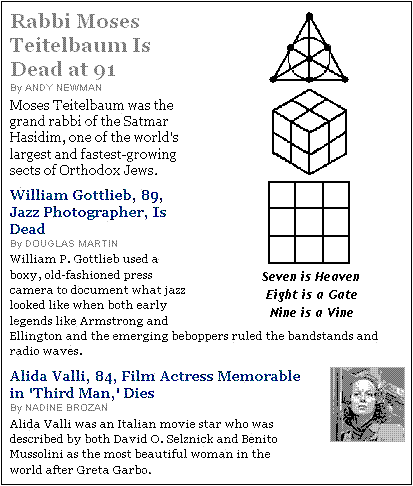
Sources: today's New York Times
and the five Log24 entries ending
on the morning of April 7, 2006:
ART WARS
in Poetry Month
Of what use the above trinity
might be to Rebecca, I am unsure.
I find it helpful in traveling back to
a summer night on 52nd St. in 1948…

Saturday, April 8, 2006
Saturday April 8, 2006
Welcome to our imaginative and inspiring toy catalog!
Today is Wednesday 7-April 2004. On this day in 30 Jesus crucified by Roman troops in Jerusalem (scholars’ estimate).
Friday, December 16, 2005
Friday December 16, 2005
A Brief Chronology
In 1946, Robert Graves published “King Jesus, an historical novel based on the theory and Graves’ own historical conjecture that Jesus was, in fact, the rightful heir to the Israelite throne… written while he was researching and developing his ideas for The White Goddess.”
In 1948, C. S. Lewis finished the first draft of The Lion, The Witch, and The Wardrobe, a novel in which one of the main characters is “the White Witch.”
In 1948, Robert Graves published The White Goddess.
In 1949, Robert Graves published Seven Days in New Crete [also titled Watch the North Wind Rise], “a novel about a social distopia in which Goddess worship is (once again?) the dominant religion.”
Lewis died on November 22, 1963, the day John F. Kennedy was killed.
Related material:
Log24, December 10, 2005
Graves died on December 7 (Pearl Harbor Day), 1985.
Related material:
Log24, December 7, 2005, and
Log24, December 11, 2005
Jesus died, some say, on April 7 in the year 30 A.D.
Related material:
Art Wars, April 7, 2003:
Geometry and Conceptual Art,Eight is a Gate, and
Plato’s Diamond

— Motto of
Plato’s Academy
bless me, what do they
teach them at these schools?”
the Narnia Chronicles
“How much story do you want?”
— George Balanchine
Tuesday, October 18, 2005
Tuesday October 18, 2005
11:07:16
"Serious numbers
will always be heard."
— Paul Simon (64 on Oct. 13)
"Her wall is filled with pictures."
— Chuck Berry (79 today)

Collegiate Church of
St. Mary Magdalene,
Atrani, Amalfi Coast, Italy:
"An interior made exterior"
— Wallace Stevens
Friday, July 1, 2005
Friday July 1, 2005
Big Dreams
“For more than a century, Los Angeles has been synonymous with big dreams. The Australian writer and critic Clive James said it this way. ‘Call Los Angeles any dirty name you like… The fact remains that you are already living in it before you get there.'”
— Today’s inaugural address by Mayor Villaraigosa
See also the previous entry.
Update of 2:24 PM July 2:
Yesterday afternoon I picked up a copy of George Steiner’s Grammars of Creation I had ordered. A check of Amazon.com to see what others had to say about this book yielded the following:
“Steiner’s account of Hope as something exclusively transcendental and relative to the future is poor and superficial: the person who hopes is not only walking ‘towards’ Eternal Life, but is already walking ‘in’ Eternal Life, walking the Kingdom.”
— Matías Cordero, Santiago, Chile
See also an entry of April 7, 2005, Nine is a Vine.
Friday, September 19, 2003
Friday September 19, 2003
The Mysteries of 26
My entry of May 26, 2003 —
dealt with the question of whether this number, said to be of significance (as a number of dimensions) in theoretical physics, has any purely mathematical properties of interest.

That entry contained the above figure, a so-called Levi graph illustrating point/line incidence in the finite projective plane with 13 points and 13 lines, PG(2,3).
It turns out that in a paper of April 7, 2000, John H. Conway and Christopher S. Simons discussed a close connection between this plane and the Monster group. See
(Journal of Algebra. Vol. 235, no. 2.
MR 2001k:20028).
Conway had written about such a connection as early as 1985.
I apologize for not knowing about this sooner, and so misleading any mathematical readers about the number 26, which it seems does have considerable purely mathematical significance.
Monday, September 8, 2003
Monday September 8, 2003
Goodbye and Hello
Larry Rodgers
The Arizona Republic
Aug. 24, 2003 12:00 AM:
"If any musician can look death in the eye and smile, it's California-based songwriter extraordinaire Warren Zevon."
From April 7, 2003:
April is Math Awareness Month.
This year's theme is "mathematics and art."

From an entry yesterday on looking death in the eye and smiling:
Such serenity "is indestructible and only increases with age and nearness to death. It is the secret of beauty and the real substance of all art."
From an entry earlier today on a circle of souls in the sun:
"they lovingly welcome two more into their company."
Frost died on September 1.
The above picture by Frost is from
Monday, August 18, 2003
Monday August 18, 2003
Entries since Xanga’s
August 10 Failure:
Sunday, August 17, 2003 2:00 PM
A Thorny Crown of…

From the first episode of
the television series
“The West Wing“:
|
Original airdate: Sept. 22, 1999 MARY MARSH CALDWELL MARY MARSH JOSH TOBY [A stunned silence. Everyone stares at Toby.] TOBY (CONT.) JOSH |
Going There, Part I
|
Crown of Ideas Kirk Varnedoe, 57, art historian and former curator of the Museum of Modern Art, died Thursday, August 14, 2003. From his New York Times obituary: ” ‘He loved life in its most tangible forms, and so for him art was as physical and pleasurable as being knocked down by a wave,’ said Adam Gopnik, the writer and a former student of his who collaborated on Mr. Varnedoe’s first big show at the Modern, ‘High & Low.’ ‘Art was always material first — it was never, ever bound by a thorny crown of ideas.’ ” For a mini-exhibit of ideas in honor of Varnedoe, see Verlyn Klinkenborg on Varnedoe: “I was always struck by the tangibility of the words he used…. It was as if he were laying words down on the table one by one as he used them, like brushes in an artist’s studio. That was why students crowded into his classes and why the National Gallery of Art had overflow audiences for his Mellon Lectures earlier this year. Something synaptic happened when you listened to Kirk Varnedoe, and, remarkably, something synaptic happened when he listened to you. You never knew what you might discover together.” Perhaps even a “thorny crown of ideas“?
“Crown of Thorns” Varnedoe’s death coincided with “To what extent does this idea of a civic life produced by sense of adversity correspond to actual life in Brasília? I wonder if it is something which the city actually cultivates. Consider, for example the cathedral, on the monumental axis, a circular, concrete framed building whose sixteen ribs are both structural and symbolic, making a structure that reads unambiguously as a crown of thorns; other symbolic elements include the subterranean entrance, the visitor passing through a subterranean passage before emerging in the light of the body of the cathedral. And it is light, shockingly so….” — Modernist Civic Space: The Case of Brasilia, by Richard J. Williams, Department of History of Art, University of Edinburgh, Scotland |
Going There, Part II
|
Simple, Bold, Clear Art historian Kirk Varnedoe was, of course, not the only one to die on the day of the Great Blackout. Claude Martel, 34, a senior art director of The New York Times Magazine, also died on Thursday, August 14, 2003. Janet Froelich, the magazine’s art director, describes below a sample of work that she and Martel did together: “A new world of ideas” Froelich notes that “the elements are simple, bold, and clear.” For another example of elements with these qualities, see my journal entry The flag design in that entry
Note that the elements of the flag design have the qualities described so aptly by Froelich– simplicity, boldness, clarity:
They share these qualities with the Elements of Euclid, a treatise on geometrical ideas. For the manner in which such concepts might serve as, in Gopnik’s memorable phrase, a “thorny crown of ideas,” see “Geometry for Jews” in ART WARS: Geometry as Conceptual Art. See also the discussion of ideas in my journal entry on theology and art titled Understanding: On Death and Truth and the discussion of the word “idea” (as well as the word, and the concept, “Aryan”) in the following classic (introduced by poet W. H. Auden):
|
Saturday, August 16, 2003 6:00 AM
Varnedoe’s Crown
Kirk Varnedoe, 57, art historian and former curator of the Museum of Modern Art, died Thursday, August 14, 2003.
From his New York Times obituary:
” ‘He loved life in its most tangible forms, and so for him art was as physical and pleasurable as being knocked down by a wave,’ said Adam Gopnik, the writer and a former student of his who collaborated on Mr. Varnedoe’s first big show at the Modern, ‘High & Low.’ ‘Art was always material first — it was never, ever bound by a thorny crown of ideas.’ “
For a mini-exhibit of ideas in honor of Varnedoe, see
Verlyn Klinkenborg on Varnedoe:
“I was always struck by the tangibility of the words he used…. It was as if he were laying words down on the table one by one as he used them, like brushes in an artist’s studio. That was why students crowded into his classes and why the National Gallery of Art had overflow audiences for his Mellon Lectures earlier this year. Something synaptic happened when you listened to Kirk Varnedoe, and, remarkably, something synaptic happened when he listened to you. You never knew what you might discover together.”
Perhaps even a “thorny crown of ideas”?

“Crown of Thorns”
Cathedral, Brasilia
Varnedoe’s death coincided with
the Great Blackout of 2003.
“To what extent does this idea of a civic life produced by sense of adversity correspond to actual life in Brasília? I wonder if it is something which the city actually cultivates. Consider, for example the cathedral, on the monumental axis, a circular, concrete framed building whose sixteen ribs are both structural and symbolic, making a structure that reads unambiguously as a crown of thorns; other symbolic elements include the subterranean entrance, the visitor passing through a subterranean passage before emerging in the light of the body of the cathedral. And it is light, shockingly so….”
— Modernist Civic Space: The Case of Brasilia, by Richard J. Williams, Department of History of Art, University of Edinburgh, Scotland
Friday, August 15, 2003 3:30 PM
ART WARS:
The Boys from Brazil
It turns out that the elementary half-square designs used in Diamond Theory

also appear in the work of artist Nicole Sigaud.
Sigaud’s website The ANACOM Project has a page that leads to the artist Athos Bulcão, famous for his work in Brasilia.
From the document
Conceptual Art in an
Authoritarian Political Context:
Brasilia, Brazil,
by Angélica Madeira:
“Athos created unique visual plans, tiles of high poetic significance, icons inseparable from the city.”
As Sigaud notes, two-color diagonally-divided squares play a large part in the art of Bulcão.
The title of Madeira’s article, and the remarks of Anna Chave on the relationship of conceptual/minimalist art to fascist rhetoric (see my May 9, 2003, entries), suggest possible illustrations for a more politicized version of Diamond Theory:
|
Fahne, |

Dr. Mengele, |

Is it safe?
These illustrations were suggested in part by the fact that today is the anniversary of the death of Macbeth, King of Scotland, and in part by the following illustrations from my journal entries of July 13, 2003 comparing a MOMA curator to Lady Macbeth:
|
Die Fahne Hoch, |
|
Thursday, August 14, 2003 3:45 AM
Famous Last Words
The ending of an Aug. 14 Salon.com article on Mel Gibson’s new film, “The Passion”:
” ‘The Passion’ will most likely offer up the familiar puerile, stereotypical view of the evil Jew calling for Jesus’ blood and the clueless Pilate begging him to reconsider. It is a view guaranteed to stir anew the passions of the rabid Christian, and one that will send the Jews scurrying back to the dark corners of history.”
— Christopher Orlet
“Scurrying”?! The ghost of Joseph Goebbels, who famously portrayed Jews as sewer rats doing just that, must be laughing — perhaps along with the ghost of Lady Diana Mosley (née Mitford), who died Monday.
This goes well with a story that Orlet tells at his website:
“… to me, the most genuine last words are those that arise naturally from the moment, such as

Joseph Goebbels |
Voltaire’s response to a request that he foreswear Satan: ‘This is no time to make new enemies.’ ”
For a view of Satan as an old, familiar, acquaintance, see the link to Prince Ombra in my entry last October 29 for Goebbels’s birthday.
Wednesday, August 13, 2003 3:00 PM
Best Picture
For some reflections inspired in part by
- Today’s anniversary of a
1727 Moravian Pentecost, - An April 7, 2003,
lecture at Moravian College, and - St. Bonaventure’s 1259
remarks on the Trinity,
Tuesday, August 12, 2003 4:44 PM
Atonement:
A sequel to my entry “Catholic Tastes” of July 27, 2003.
Some remarks of Wallace Stevens that seem appropriate on this date:
“It may be that one life is a punishment
For another, as the son’s life for the father’s.”
— Esthétique du Mal, Wallace Stevens

“Unless we believe in the hero, what is there
To believe? ….
Devise, devise, and make him of winter’s
Iciest core, a north star, central
In our oblivion, of summer’s
Imagination, the golden rescue:
The bread and wine of the mind….”
— Examination of the Hero in a Time of War, Wallace Stevens
Etymology of “Atonement”:
“Middle English atonen, to be reconciled, from at one, in agreement“
At One
“… We found,
If we found the central evil, the central good….
… we and the diamond globe at last were one.”
— Asides on the Oboe, Wallace Stevens
Tuesday, August 12, 2003 1:52 PM
Franken & ‘Stein,
Attorneys at Law
“Tue August 12, 2003 04:10 AM ET
NEW YORK (Reuters) – Fox News Network is suing humor writer Al Franken for trademark infringement over the phrase ‘fair and balanced’ on the cover of his upcoming book, saying it has been ‘a signature slogan’ of the network since 1996.”
|
Franken: |
‘Stein: |
For answers, click on the pictures
of Franken and ‘Stein.
Monday, April 28, 2003
Monday April 28, 2003
ART WARS:
Toward Eternity
April is Poetry Month, according to the Academy of American Poets. It is also Mathematics Awareness Month, funded by the National Security Agency; this year's theme is "Mathematics and Art."
Some previous journal entries for this month seem to be summarized by Emily Dickinson's remarks:
"Because I could not stop for Death–
He kindly stopped for me–
The Carriage held but just Ourselves–
And Immortality.
Since then–'tis Centuries–and yet
Feels shorter than the Day
I first surmised the Horses' Heads
Were toward Eternity– "
|
Math Awareness Month April is Math Awareness Month.
|
|
An Offer He Couldn't Refuse Today's birthday: Francis Ford Coppola is 64.
From a note on geometry of April 28, 1985:
|
|
The Eight Today, the fourth day of the fourth month, plays an important part in Katherine Neville's The Eight. Let us honor this work, perhaps the greatest bad novel of the twentieth century, by reflecting on some properties of the number eight. Consider eight rectangular cells arranged in an array of four rows and two columns. Let us label these cells with coordinates, then apply a permutation.
The resulting set of arrows that indicate the movement of cells in a permutation (known as a Singer 7-cycle) outlines rather neatly, in view of the chess theme of The Eight, a knight. This makes as much sense as anything in Neville's fiction, and has the merit of being based on fact. It also, albeit rather crudely, illustrates the "Mathematics and Art" theme of this year's Mathematics Awareness Month. The visual appearance of the "knight" permutation is less important than the fact that it leads to a construction (due to R. T. Curtis) of the Mathieu group M24 (via the Curtis Miracle Octad Generator), which in turn leads logically to the Monster group and to related "moonshine" investigations in the theory of modular functions. See also "Pieces of Eight," by Robert L. Griess. |
Wednesday, April 23, 2003
Wednesday April 23, 2003
Midnight in the Garden
of Good and Evil
on Shakespeare’s Birthday
Tony Scherman on an April 7, 1968, recording by Nina Simone:
“…nobody could telescope more emotion into a single, idiosyncratically turned syllable (listen to the way she says the word “Savannah” in her spoken intro to “Sunday in Savannah.” It breaks your heart — and she ain’t even singin’ yet!).”
See also the following entries on midnight in the garden:
Trinity, Oct. 25, 2002
Midnight in the Garden, Oct. 26, 2002
Point of No Return, Dec. 10, 2002
Culture Clash at Midnight, Dec. 11, 2002
Dead Poets Society, Dec. 13, 2002
For the Dark Lady, Dec. 18, 2002
Nightmare Alley, Dec. 21, 2002
For the Green Lady, Dec. 21, 2002
“With a little effort, anything can be shown to connect with anything else: existence is infinitely cross-referenced.”
— Opening sentence of Martha Cooley’s The Archivist
|
Woe unto Isaiah 5:20
|

As she spoke about the Trees of Life and Death, I watched her…. |
The world Cole Porter
|
Tuesday, April 15, 2003
Tuesday April 15, 2003
Green and Burning
After posting the 2:42 PM entry at a public library this afternoon, I picked up the following at a “Friends of the Library” used-book sale:
The Green and Burning Tree:
On the Writing and Enjoyment
of Children’s Books,
by Eleanor Cameron (Little, Brown and Company, Boston and Toronto, 1969).
Cameron, on page 73, gives the source of her title; it is from the Mabinogion:
“And they saw a tall tree by the side of the river, one half of which was in flames from the root to the top, and the other half was green and in full leaf.”
Cameron finds the meaning of this symbol in Dylan Thomas: His Life and Work, by John Ackerman (Oxford University Press, 1964), p. 6:
“Another important feature of the old Welsh poetry is an awareness of the dual nature of reality, of unity in disunity, of the simultaneity of life and death, of time as an eternal moment rather than as something with a past and future.”
For part of a Nobel Prize lecture on this topic — time as an eternal moment — see Architecture of Eternity, a journal note from December 8, 2002.
That lecture is from an author, Octavio Paz, who wrote in Spanish. Here are some other words in that language:
Mi verso es de un verde claro,
Y de un carmín encendido.My verse is a clear green,
And a burning crimson.
These lyrics to the song “Guantanamera” (see Palm Sunday) were on my mind this afternoon when Cameron’s book caught my eye.
Green and crimson are, of course, also the colors of Christmas, or “Christ Mass.” In view of the fact that Cameron’s book is about children’s literature, this leads, like it or not, to the following meditation.
From a religious site:
Matthew 18:3 – And said, Truly I say to you, Unless you are converted, and become like little children, you shall not enter into the kingdom of heaven.
Mark 10:15 – Truly I say to you, Whoever shall not receive the kingdom of God as a little child shall not enter it at all.
Luke 18:17 – Truly I say to you, Whoever does not receive the kingdom of God as a little child shall by no means enter it.
A meditation from a less religious site:
“What I tell you three times is true.”
Finally, from what I now consider
- in view of the song lyrics quoted above,
- in view of the fact that it deals with a Cuban movie also titled “Guantanamera,”
- in view of Cameron’s remarks on Bergman’s “The Seventh Seal” (p. 129), and
- in view of my April 7 entry on mathematics and art,
to be an extremely religious site, a picture:

Tuesday, April 8, 2003
Tuesday April 8, 2003
Death's Dream Kingdom
April 7, 2003, Baghdad – A US tank blew a huge statue of President Saddam Hussein off its pedestal in central Baghdad on Monday with a single shell, a US officer said…. "One shot, one kill."
"When smashing monuments, save the pedestals; they always come in handy."
|
"In death's dream kingdom….
Between the idea — T. S. Eliot, Harvard 1910, The Hollow Men
"A light check in the shadow — Edward H. Adelson, Yale 1974, Illusions and Demos "point A / In a perspective that begins again / At B" — Wallace Stevens, Harvard 1901, "The Rock" See also |






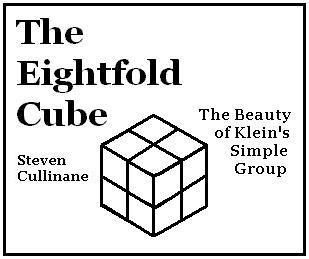









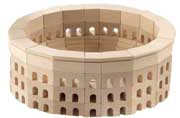 The Coliseum Builder Block System can be used to recreate the Roman Coliseum. Reenact ancient Gladiator matches and bring Ancient Rome into your home.
The Coliseum Builder Block System can be used to recreate the Roman Coliseum. Reenact ancient Gladiator matches and bring Ancient Rome into your home. 










